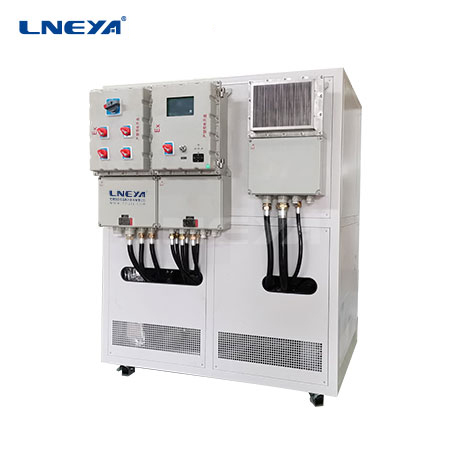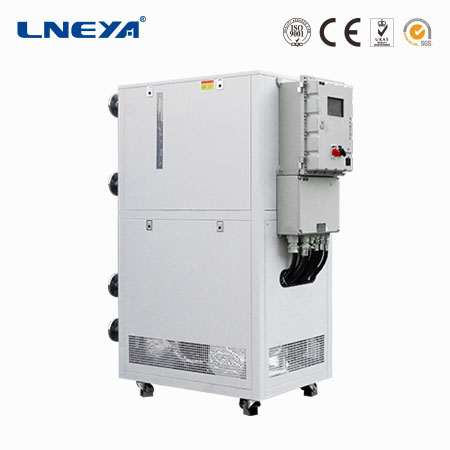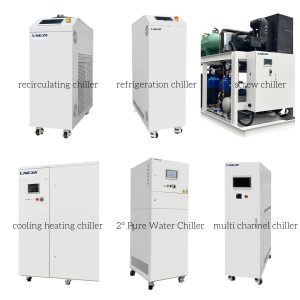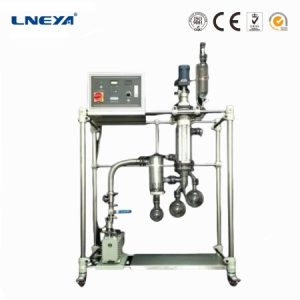Distillation tower process chiller heating system
Distillation towers and distillation tower processes indeed require chillers and heating systems to maintain temperature control during the process, ensuring effective separation and purification operations.
The top temperature of the tower is generally controlled within a lower range to ensure effective separation and purification. For example, for some general distillation operations, the top temperature of the tower may be controlled at around 79℃, but this is not an absolute value, which needs to be determined based on the boiling point of the separated substance and the operating pressure.
The bottom temperature of the tower needs to be higher than the boiling point of the lowest boiling component in the material, but it should not be too high to prevent the high boiling component from being evaporated in large quantities, which will affect the separation effect. Generally speaking, the bottom temperature of the tower may be controlled between 105 and 107℃, but the specific values need to be adjusted based on actual operating conditions and material characteristics.
Chiller function
Cooling reflux liquid: At the top of the distillation tower, the vapor is cooled into a liquid through the condenser, which is usually sent back to the top as reflux liquid to help maintain the gas-liquid balance and purification effect inside the tower. The cold water provided by the chiller flows through the condenser to effectively condense the steam.
Control the temperature at the top of the tower: By precisely controlling the cooling water volume and temperature entering the condenser through the chiller, the temperature at the top of the tower can be precisely adjusted, which is crucial for controlling the separation purity of the product.
Maintain system thermal balance: During distillation and distillation processes, a large amount of heat is generated, and the chiller helps to remove this excess heat, maintain the thermal balance of the entire system, and prevent efficiency reduction or equipment damage caused by overheating.
- MORE
LT -45℃~30℃
LOW TEMPERATURE COOLING CIRCULATOR For fast liquid cooling 1. Can use ethylene glycol mixed with water for circulating refrigeration, saving resources 2.Circulating pipeline design, prolong t…
- MORE
LT 10℃~30℃
Saving water resources & circulating cooling 1. Can use ethylene glycol mixed with water for circulating refrigeration, saving resources 2.Circulating pipeline design, prolong the use time of circulating …
- MORE
LT -25℃~30℃
Rapid refrigeration using imported brand semi-enclosed piston compressor, semi-enclosed piston two-stage compressor, semi-enclosed screw compressor 1. Can use ethylene glycol mixed …
loading…
已经是到最后一篇内容了!
Heating system function
Provide heat: At the bottom of the tower, the heating system (usually a reboiler) heats the raw materials, promoting the evaporation of low boiling components and forming rising steam. The heat supply of the heating system must be sufficient and stable to ensure continuous distillation operations.
Control the temperature at the bottom of the tower: By adjusting the heating intensity, the temperature at the bottom of the tower can be controlled, which in turn affects the distillation rate and the evaporation efficiency of the materials. This is very important for controlling the vapor-liquid balance and separation effect of the materials inside the tower.
Promote material flow: Proper heating also helps with the flow of materials inside the tower, avoiding local overheating or prolonged material residence time, which can affect product quality.
- MORE
UC series
WhatsApp: 86 13912479193 WeChat 86 15152266993 Fully enclosed system, heat transfer oil will not be oxidized or browning …
- MORE
UST series
It is suitable for the needs of various process production and experimental use in pharmaceutical and chemical enterprises. It can realize high temperature cooling process, directly cooling from high temperature of 300 degrees t…
loading…
已经是到最后一篇内容了!
In summary, chillers and heating systems play a crucial role in distillation and distillation processes. Chillers are responsible for condensation and cooling, while heating systems are responsible for evaporation and providing necessary heat. The collaboration between the two ensures the efficient and stable operation of the process and the high-quality separation of products.
Related recommendations
-
The role of recirculating heaters in chemical and biological reaction instruments
772Temperature Control: The recirculating heater provides a precise and stable temperature control environment, which is a crucial factor in chemical and biological reactions. Different chemical reactions and biological processes have spec...
View details -
What is a chiller? Everything You Should Know
799A process chiller can help you moves heat away from the area you need to cool. It is often used in a variety of processes that require precise temperature control.Want to know more about chillers? Contact us! market@lneya.com
View details -
Does hydrogen energy manufacturing require process chillers for cooling?
822Process chillers are indeed needed in the hydrogen energy manufacturing process. Especially in the production of hydrogen, such as hydrogen production by water electrolysis, a lot of heat is generated in this process. The electrolyze...
View details -
Molecular distillation (Short range distillation)
1723Short range distillation (molecular distillation) is a new separation technology that can solve problems that conventional distillation techniques cannot solve. It can achieve liquid-liquid separation at temperatures far below the boilin...
View details
 LNEYA Industrial Chillers Manufacturer Supplier
LNEYA Industrial Chillers Manufacturer Supplier

















